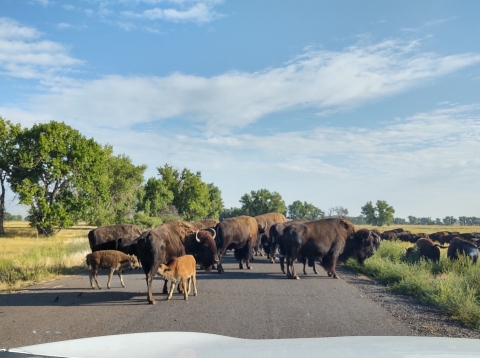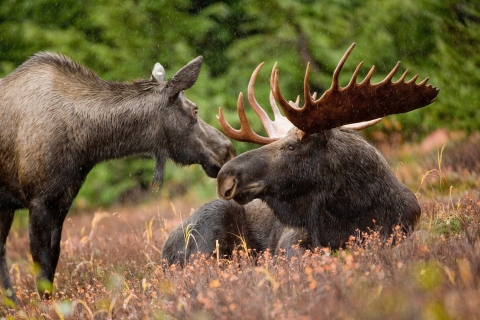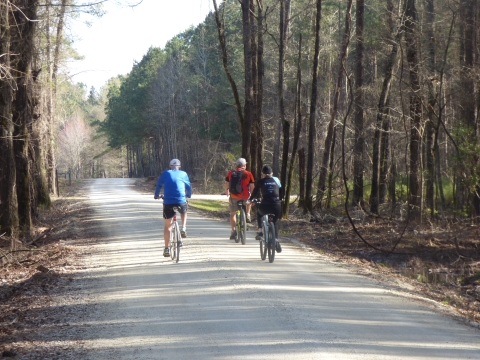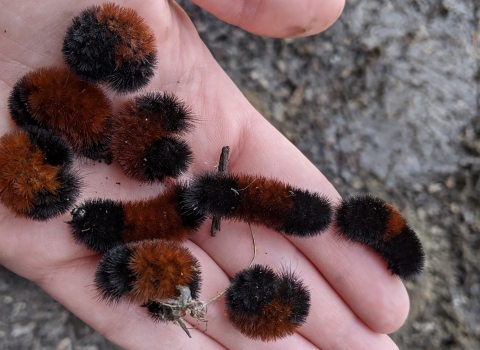To really explore a national wildlife refuge national wildlife refuge
A national wildlife refuge is typically a contiguous area of land and water managed by the U.S. Fish and Wildlife Service for the conservation and, where appropriate, restoration of fish, wildlife and plant resources and their habitats for the benefit of present and future generations of Americans.
Learn more about national wildlife refuge , of course, you’ll want to get out of your car.
But sometimes time is short, or you want to get the lay of the land before you set out on foot. We get it.
For all you let’s-check-it-out-first types, here’s a sampling of some super refuge drives to whet your appetite for the next step.
Bosque del Apache National Wildlife Refuge, New Mexico
An hour and a half from Albuquerque, a 12-mile auto loop along refuge wetlands offers great views of the Chupadera and San Pascual Mountains. From late October through January, see flocks of sandhill cranes and snow geese fly out at dawn to feed in fields and return at dusk to roost in the marshes.
Take the historic route: El Camino Real National Scenic Byway has historic attractions commemorating a route that connected Mexico City and Santa Fe for hundreds of years.
Wildlife to look for: Sandhill cranes, snow geese, Ross's geese and ducks.
Lower Klamath and Tule Lake National Wildlife Refuges, California and Oregon
Separate drives at this pair of refuges along the California-Oregon border feature birds galore and stunning views of Mount Shasta. Access the 10.2-mile Lower Klamath loop from Stateline Highway 161, 12 miles from the refuge visitor center. An alternative east-side route offers access to a hike along the refuge’s southernmost boundary and seasonal views of sandhill cranes. Pick up the Tule Lake tour route five miles south of the visitor center. Reach both refuges from the Volcanic Legacy Scenic Byway All-American Road between Oregon’s Crater Lake and California’s Mount Lassen.
Wildlife to look for: Ducks and geese (spring/fall), white pelicans and western grebes (summer), and bald eagles and other raptors (winter). Sandhill cranes, tundra swans and other species can be seen at various times of the year.
J.N. “Ding” Darling National Wildlife Refuge, Florida
A four-mile wildlife drive on Sanibel Island winds through mangrove forest, cordgrass marsh and hardwood hammocks, offering close-up views of wading birds, shorebirds, seabirds, waterfowl and raptors. Bicycling is also popular on the paved route, part of the island’s system of multi-use trails.
Wildlife to look for: Roseate spoonbills, wood storks, reddish egrets, little blue herons, yellow-crowned night-herons, anhingas, white pelicans, red knots, marbled godwits, bald eagles, otters, bobcats and alligators.
Rocky Mountain Arsenal National Wildlife Refuge, Colorado
One of the best ways to experience this 15,000-acre refuge just outside Denver is by taking the 11-mile wildlife drive auto tour in your vehicle. Listen to the podcast, which corresponds with each mile marker to learn more about the refuge and its wildlife. The wildlife drive takes 45 minutes to 1 hour to complete.
Wildlife to look for: Bison, prairie dogs, black-footed ferrets, burrowing owls, coyotes and cottontail rabbits.
Bombay Hook National Wildlife Refuge, Delaware
A 12-mile wildlife drive cuts across man-made pools, salt marshes, mudflats, woodlands and upland fields. Spring brings migrating waterfowl, wood warblers and shorebirds. Summer draws herons, egrets, avocets, black-necked stilts and terns. Fall and winter months provide resting and wintering grounds for Canada geese, snow geese and a mix of waterfowl. Birds of prey are seen all year long. The drive passes five short walking trails, three with 30-foot-high observation towers.
Wildlife to look for: Snow geese, northern pintails, warblers, dunlins, dowitchers, avocets, black-necked stilts, yellow warblers, purple martins, red tailed hawks and bald eagles.
Kenai National Wildlife Refuge, Alaska
Skilak Loop Wildlife Drive, an 18.5-mile gravel loop off the Sterling Highway, leads through a black spruce forest and along Skilak Lake and Engineer Lake, passing several scenic overlooks. Several hiking trails are accessible from the loop.
Wildlife to look for: Moose, bear, spruce grouse, snowshoe hares, beaver, lynx, eagles and peregrine falcons.
Wichita Mountains Wildlife Refuge, Oklahoma
Take a three-mile drive to the top of Mount Scott for a panoramic view of the Wichita Mountain range. Between mountain peaks, see some of country’s last untilled native prairie, where bison and cattle roam among oaks and greenbriar. Every September the Annual Bison Roundup culls the animals for testing and sale, donation or return to the herd. State Highway 49, which goes about 20 miles through the refuge, is another scenic drive. Both roads are part of the Wichita Mountains National Scenic Byway, as designated by the Federal Highway Administration.
Wildlife to look for: Texas Longhorn cattle, bison, elk, deer, coyotes, red-tailed hawks, prairie dogs, turkey and bobcat.
Ridgefield National Wildlife Refuge, Washington
Along the bank of the Columbia River, a 4.2-mile gravel loop road crosses fields, wetlands, sloughs, and forests, and is easily the refuge's most popular visitor destination. The auto tour provides a sense of the refuge landscape while making it easy to spy birds and other wildlife, especially at an observation blind.
Wildlife to look for: Migrant bird species, such as sandhill cranes, as well as resident bird species, such as mallards, great blue herons and red-tailed hawks. Coyote, raccoon, skunk, beaver and river otter are occasionally seen.
National Elk Refuge, Wyoming
Two-lane Refuge Road is a scenic, flat to rolling dirt road that offers a view of the Grand Tetons and a chance to see elk and bighorn sheep. Expect to find the road snow-covered in winter. The roughly four-mile road begins at the east end of Broadway, at the entrance to the refuge.
Wildlife to look for: Elk, bison, wolves, trumpeter swans, bald eagles and bighorn sheep.
Des Lacs National Wildlife Refuge, North Dakota
The 19-mile Refuge Backway follows the gently rolling hills of upland prairie, offering excellent views of these and the wooded draws of the Des Lacs Valley, with great scenery and wildlife viewing opportunities. More than 250 species of birds, including waterfowl, raptors and many other migrants, have been seen there, along with deer, moose and other mammals. The Backway also contains the trailhead for Munch's Coulee National Recreation Trail National Recreation Trail
A National Recreation Trail is a land-based or water-based trail that provides an outdoor recreation opportunity on federal, state, tribal or local public land. National Recreation Trails were established by the National Trails System Act of 1968 (Public Law 90-543), which authorized creation of a national trails system composed of National Recreation Trails, National Scenic Trails and National Historic Trails. Whereas National Scenic Trails and National Historic Trails may be designated only by an act of Congress, National Recreation Trails may be designated by the Secretary of the Interior or the Secretary of Agriculture to recognize exemplary trails of local and regional significance.
Learn more about National Recreation Trail , a mile-long loop with a universally accessible section; the trailway provides panoramic views and opportunities to see wildlife.
Wildlife to look for: Mergansers and snow geese in the spring and fall, several species of grebes in summer, as well as wild turkeys, white-tailed deer and moose.
Santee National Wildlife Refuge, South Carolina
The refuge's 7.5-mile auto tour route offers opportunities for seeing many wildlife species and beautiful landscapes.
Wildlife to look for: Alligators, largemouth bass, painted buntings, indigo buntings, blue grosbeaks, crappie and catfish.
Tamarac National Wildlife Refuge, Minnesota
A five-mile ride along Blackbird Wildlife Drive winds through coniferous and deciduous forests to pristine lakeshores. Plan a stop at the wheelchair-accessible observation deck with viewing scopes. Wildflowers bloom along road from spring to fall. Roll your window down in the spring to hear the swans, loons and frogs calling. The end of the tree-covered drive has spectacular color in the fall.
Wildlife to see: Trumpeter swans, common loons, white-tailed deer, beaver, river otters, bald eagles, osprey, black bear, turtles and songbirds.








